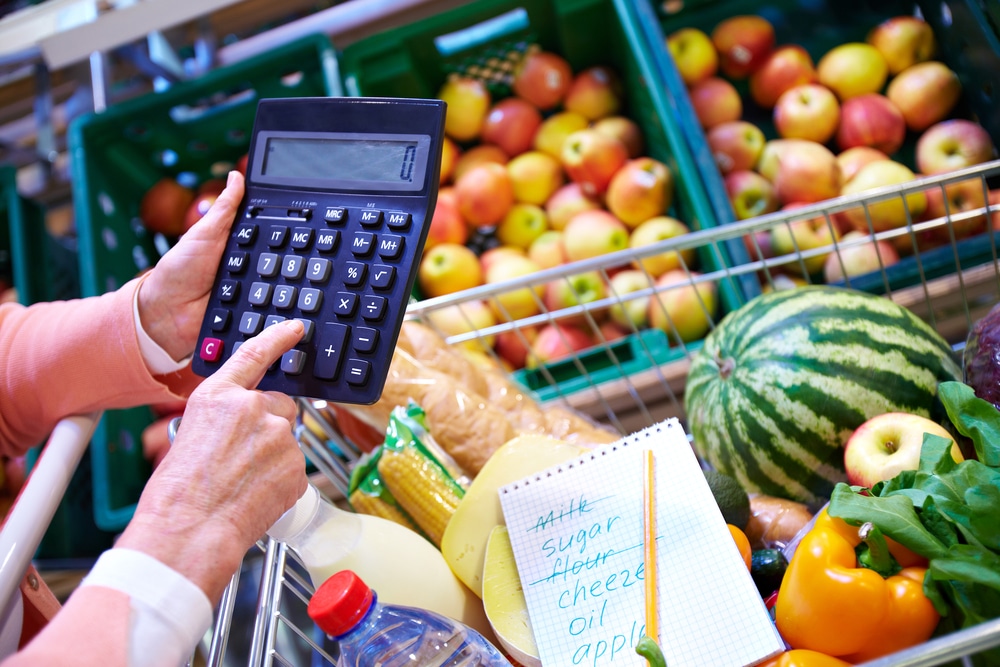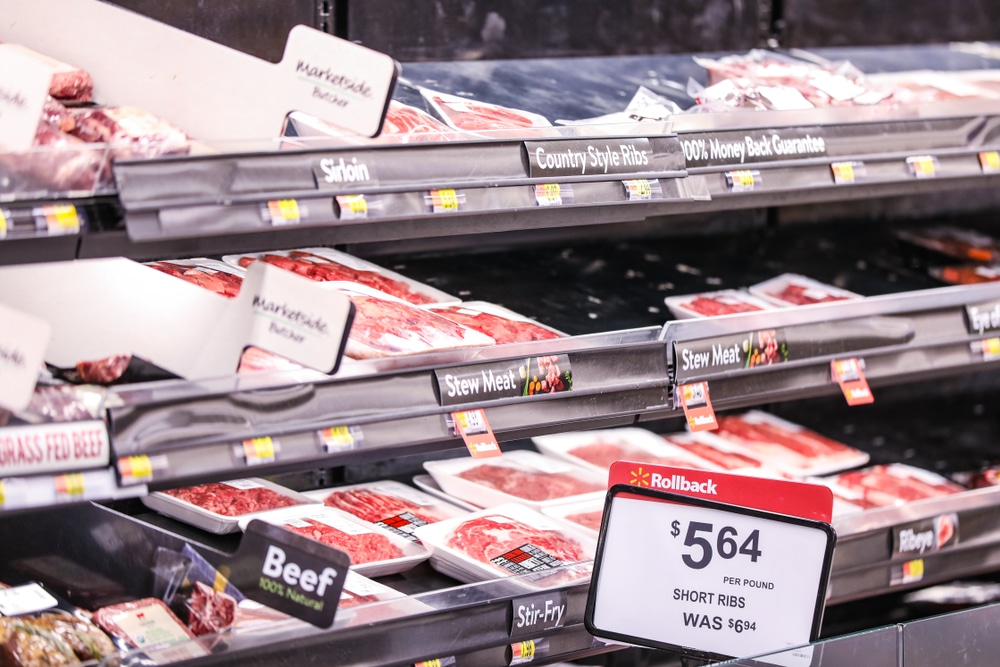If there’s one budget category that can easily ‘run away’ it’s groceries. I have so many friends and family that often overspend on groceries by $50 a month, $100 a month, and some that budget $200 and end up spending double!

However, there are a number of different things you can do to help you stick to a budget at the grocery store including; meal planning, making a list (and sticking to it), using a calculator or shop scanner to track how much you’re spending as you go around the store.
In this post, we’re going to go through the multiple different things I do to stick to a very strict grocery budget successfully.
These techniques are tried and tested and have worked for me for over a decade!
Make A List
Successfully sticking to a grocery budget requires preparation. You’ll notice that a number of these techniques actually take place before our trip to the grocery store.
Honestly, if you only take away a handful of methods from this article make sure it’s the ones about research and preparation.
This all starts with making a list.
Personally, I start by ‘shopping at home’. I take 15 minutes to go through my fridge, freezer and pantry to see what I have.

How many times have you gone to the store and purchased items that you already have at home that you forgot about?
I use this list of items as the core of my meal plan for the week.
I use cookbooks, Pinterest, and family favorites to create a list of meals I can make with the items (or meals that only need an item or two more from the grocery store) and map these into a meal plan.
Unlike the majority of meal plans that only focus on dinners, I look to cover everything. Breakfast, lunch, dinner, and snacks. After all, those are the things we’re eating, not just dinner.
Personally, I find this especially important as I work from home. However, this is just as important as it will help you with prepping meals to take to work. Which should, in turn, prevent you from spending money in the work cafeteria or eating out as much.

Once I’ve mapped meals onto my meal plan using the ingredients I already have at home. I fill the remaining slots with other meals we fancy and add the ingredients required onto my list.
Having a list will ensure that you get everything you need from the grocery store in one trip. This is especially important as statistics show that the more trips you make to the grocery store, the more you spend.
Avoid Pre-Prepaired Food
While you may find pre-prepared food such as fruit bowls and salad bowls more convenient (especially if you have a big family) the cost per pound is significantly higher.

Instead, I recommend buying ingredients and preparing the food either by chopping, slicing, or fully preparing meals during an afternoon once a week.
However, if it’s between you going out for dinner or buying a pre-prepared meal then it’s certainly better to buy prepared. Even if this means going over your grocery budget the cost overall is going to be significantly cheaper.
Choose Your Grocery Store Wisely
The same cart at one grocery store could cost 10% more at another.
This average difference (such as $20 if your cart is $200) can often be the difference between staying on budget or not.
Depending on the amount of time you have to research prior to your trip to the store you could opt to match up items on your list with items on sale at the stores (based on promotions you’ve found online – more on this below)

Alternatively, you could simply opt to shop at the cheapest store which I’ve found to be Aldi.
If you don’t have an Aldi nearby, my second cheapest is Walmart followed by Trader Joes’.
If you don’t have time to research in advance consider heading to one store one week and jotting down the prices (I’d opt for prices per KG or oz) of basic items which you buy regularly.
Then the following week going to another local store and doing the same alongside your grocery shop.
Repeat this process for all the different grocery stores in your local area.

After around one month you should be able to see which store tends to be the cheapest for the majority of the products you regularly purchase.
While the process of doing this may mean you spend more time in the grocery store in the first month (and may push you slightly over budget) the long term savings will be well worth it!
Buy ‘Store Brand’ Basic Food Items
The majority of grocery stores have their own brand name products alongside well-known brands.
Store brand products are almost always cheaper than named brand products and are almost the same if you look at the ingredients.

Making the switch between premium named brands and store brands isn’t always easy. However, I suggest using a small amount of your budget each week to test a handful of these items to help you ween yourself off premium brands.
I’ve known store-brand products to cost 1/4 of the premium brand products in some cases (soup is a great example) so this can really help you save money at the grocery store and keep within your grocery budget.
This money-saving technique also applies to; over-the-counter medicines, cleaners, and other household products.
Minimise Your Meat Intake
Going vegetarian or vegan may not be for everyone.
However, meat is almost always the most expensive item on the receipt after a grocery shop.
Look to make a meal without meat, or with a meat substitute just once a week.
The average price of meat per pound in March 2019 was $4.25 while the same amount of veggies came in at $1.80.

The average meal for four includes one pound of meat so this would save you almost $2.45 on one meal alone and repeating this process once a week for the entire year would save you $127.40!
Alternatively, if giving up meat isn’t for you look to purchase it frozen or canned instead of fresh. Not only is this often cheaper per pound it also lasts significantly longer.
Reducing your food waste is certainly going to help you keep your groceries under budget long term.
Buy In Bulk
If an item you purchase regularly at the grocery store is on sale then where your budget allows buy it in bulk.
The key here is to know what a good deal really is and this is where your previous research of different stores and prices comes in.

Monitoring these prices everytime you’re in the store and tracking them either in a small notebook or on an app in your phone will help you be confident in how much you purchase when an items on offer.
Personally, wherever my budget allows I triple the amount I regularly purchase when an item is on sale.

So, if I usually buy 3 tins of soup and the soup is on sale I’d buy 9 instead.
However, this is a really flexible rule as it can be more or less depending on how good the sale is.
Check The Stores Special Offers Before Your Trip!
Check your supplements regularly to see what local grocery stores are promoting this week or month.
In most cases, grocery stores ads start on the same day every week (I think in Aldi it’s Wednesdays).

Usually, the best deals are on the front page of the ad as these are designed to get your attention and get you to the store.
However, be sure to remember that just because an item is on sale doesn’t make it a good deal. Again, this comes back to researching products and knowing what a good price truly is.
Take A Calculator (Or Your Phone!)
How many times do you stand shocked at the register as the price continues to rise past what you budgeted?
Well, if you’re on a budget, bringing a calculator – alternatively, if you’re shopping with kids get them to add items up as you go around the store putting items in the cart.

Using a calculator will help you make smarter choices; if you see that your total is increasing, you can put something back or choose to opt for a lower brand.
In some stores local to be they’ve released ‘scan as you shop’. In this case, you walk around the store as usual scanning items with a barcode scanner as you add the item to your cart.
This barcode scanner is great for double-checking the prices of items, as well as adding up how much you’ve spent!
Avoid Impulse Purchases & ‘Fake’ Sale Items
Sale items often lead to impulse purchases of items which are not on our grocery list.
This is a trick by the grocery stores to get you to spend more money.
It’s not a decent deal just because it’s on offer.

For example, if Kellogg’s goes on sale it still may not be as cheap as the own brand label you’d otherwise purchase. Therefore you’re not saving money.
The same goes for products that you’re not sure you’ll use (because it’s not in the meal plan) which will therefore likely go off before consumption and therefore be completely wasted!
